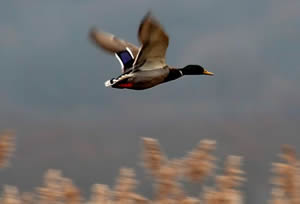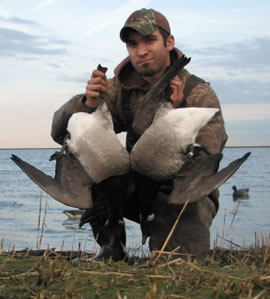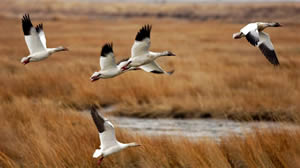2014-2015 Migratory Bird Season
|
||||||||
|
In 2014, the status of ducks and their habitats in mid-continent and eastern North America were sufficient to justify a liberal duck hunting season framework of 60 days with a 6-duck bag limit. Atlantic Flyway states, including New Jersey, have had 60-day duck seasons since 1997.
Each year, the US Fish and Wildlife Service (Service) develops migratory bird hunting regulations after input and consultation with the Atlantic, Mississippi, Central and Pacific Flyway Councils. The Flyway Councils are comprised of representatives from state and provincial wildlife agencies that work with the Service to cooperatively manage North America's migratory bird populations. Duck hunting regulations are based on biological population assessments using the Adaptive Harvest Management (AHM) process, which has been developed cooperatively by the Service and Flyway Councils. AHM is an objective, science-based regulation-setting process. During 2014, the AHM process suggested that a liberal duck hunting season in all flyways was consistent with the long-term welfare of North American waterfowl populations. |
During 2014 in the eastern survey areas, where most ducks harvested in the Atlantic Flyway breed, key species populations (including mallards, black ducks, and green-winged teal) were similar to their long-term averages. Duck species from the mid-continent (prairie) region (including American wigeon, blue-winged teal, gadwall, shovelers, and redheads) were above their respective long-term averages. The canvasback estimate was 685,000 birds which was down 13% from last year and necessitated a reduction in the daily bag limit to 1 bird. Pintails were down 20% from their long-term average which required a continuation of the more restrictive 2-bird bag. Scaup were near their long-term average and the 2-bird bag was also retained.
This year, the daily bag limit in New Jersey will be 6 ducks and may not include more than 4 mallards (including no more than 2 hens), 4 scoters, 2 scaup, 3 wood ducks, 2 redheads, 2 pintails, 1 canvasback, and 1 black duck. The bag limit is 6 ducks for all other duck species. Merganser bag limits will remain at 5 birds per day with no more than 2 hooded mergansers. Merganser bag limits are in addition to regular duck bag limits.
To better serve New Jersey's sportsmen, the Division conducted a survey of duck hunters during the winter of 2012-13. The majority of South Zone hunters indicated that they preferred to hunt later into January by taking days from the 1st split in October. Based on the results of this survey, the South Zone duck season will again run later into January at the expense of days taken from the first split in October as was the case last year. Additional information and detailed results can be found in the 2012-2013 Waterfowl Hunter Survey (pdf, 310kb).
CANADA GEESE
The "regular" Canada goose season is based on the status of Atlantic Population (AP) Canada geese which nest on the Ungava Peninsula of northern Quebec. The AP is New Jersey's primary migrant Canada goose population. A total of 183,600 breeding pairs were estimated from surveys during June, 2014. During this year's survey, 63% of the indicated pairs were observed as single birds, indicative of a strong nesting effort. The breeding population has been stable for the past 10 years and as a result, the "regular" Canada goose season will remain the same as last year with a 50-day season and 3-bird bag limit.
The Special Winter Canada Goose Season will be held January 26 to February 14, 2015, in two zones with the same hunt area boundaries as last year and a bag limit of 5 Canada geese per day. This special season is held in areas of the state that have a relatively low proportion of AP Canada geese during late winter. The determination of AP Canada goose abundance is based on leg band recovery data as well as information from previous neck band and satellite telemetry studies.
Resident Population (RP) Canada geese are overabundant throughout most of the United States and cause significant damage problems. As a result, additional hunting methods including the use of electronic calls, unplugged shotguns, extended hunting hours, and liberal bag limits are allowed during September hunting seasons. September seasons target RP geese since Atlantic Population or migrant geese do not arrive in New Jersey until October.
Hunters need to remember that these special regulations only apply to the September Canada goose season (September 1-30, 2014). Hunters that choose to use unplugged guns during the September Canada goose season are reminded to reinstall magazine plugs before pursuing other game species.
ATLANTIC BRANT
Since Atlantic brant breed in remote wilderness of the Canadian Arctic, their status is measured during January surveys on their Atlantic Flyway coastal wintering grounds. Other factors, including young production during recent years and food supply (i.e. sea lettuce and eelgrass), are also considered when determining the current year's hunting regulation.
| Although the 2014 Mid-Winter Survey estimate was 133,000 birds, brant have experienced poor young production (less than 10% young in fall flight) during the past two years, including a near "bust" during 2013 when less than 4% of the brant in the fall flight were young. This is the first time in 38 years of surveys where young production was less than 10% for two consecutive years. In addition, preliminary population estimates derived from banding data (Lincoln estimates), suggest that brant have been declining at a rate of 5% per year since 2000.
As a result of these indices of below optimum population status, the 2014 brant season will remain at 30 days with a bag limit of 2 birds. As such, the brant season will be closed during part of the duck season in all zones. Nearly all brant in New Jersey are harvested in the Coastal Zone and there are 3 primary periods of brant harvest and hunting activity: the first split in early November, Thanksgiving, and the Christmas-New Year's Holiday. As such, it was difficult to decide when to have the brant season closed while the duck season was open under the constraint that the brant season is only 30 days and can only be split into 2 segments. Given these constraints, the brant season cannot cover all 3 of these important hunting periods. |
After consultation with waterfowl groups and the Fish and Game Council, it was determined that the brant season should be open for the duration of the first duck season split in November with the balance of the days used during the Christmas-New Year's period and extending into mid-January. Hunters should check the season dates carefully and note the time periods during the duck season when the brant season is closed. In particular, hunters should note that the brant season is closed during the Thanksgiving holiday period in the Coastal Zone.
LIGHT GEESE
|
Greater and lesser snow geese, as well as Ross's geese, are collectively referred to as "light" geese. Collectively, light goose populations remain high and biologists are concerned about the impacts light geese have on fragile Arctic nesting habitats. Serious damage to Arctic wetlands has already been documented in several key light goose breeding colonies. This damage impacts the light geese themselves, as well as other wildlife dependent on the Arctic ecosystem. Serious damage to agriculture also occurs in migration and wintering areas.
As a result of this overabundance issue, the Service will again authorize implementation of a Conservation Order (CO). A CO is a special management action, authorized by the Migratory Bird Treaty Act that is needed to control certain wildlife populations when traditional management programs are unsuccessful in preventing overabundance of that population. The CO allows an extended time period outside of traditional hunting seasons as well as additional methods for taking light geese without bag limits. The intent of the CO is to reduce and/or stabilize North American light goose populations that are above population objectives. |
In the Atlantic Flyway, greater snow geese are the most abundant light goose population. The preliminary estimate from 2014 spring surveys was 796,000 birds, which is 60% above the population objective of 500,000 birds. During the past 10 years however, this population has shown a stable trend suggesting that liberal and special regulations may have stemmed the aggressive population growth that was occurring during the 1990s.
Due to the current large population size, the hunting season length for light geese will be the maximum allowed under the Migratory Bird Treaty Act (107 days) with liberal bag limits of 25 light geese per day with no possession limit. In addition, a CO will be implemented in the spring of 2015 from February 16 to April 4. During the CO, special regulations will be allowed including the use of electronic calls, shotguns capable of holding up to 7 shells, extended shooting hours, and no bag limits. Hunters interested in participating in the CO should check the migratory bird regulations and/or the Division's web site for more details on obtaining required permits and hunting activity reporting requirements.
ADDITIONAL INFORMATION
Since 1997, the US Fish and Wildlife Service has allowed states to hold Youth Waterfowl Hunting Days on weekends, holidays, or other non-school days when youth hunters would have an opportunity to participate. Youth Days are held when waterfowl seasons are closed to the general hunting public.
The objective of Youth Days is to introduce young hunters to the concepts of ethical use and stewardship of waterfowl, encourage youngsters and adults to experience the outdoors together, and to contribute to the long-term conservation of the migratory bird resource. Youth Days are a unique educational opportunity, above and beyond the regular season, which helps ensure high-quality learning experiences for youth interested in hunting.
Atlantic Flyway states are permitted to hold two Youth Days in each zone. New Jersey Youth Waterfowl Hunting Days will be October 4 and November 1 in the North Zone; October 11 and November 8 in the South Zone and October 25 and February 7 in the Coastal Zone. Note that the second Youth Day in the Coastal Zone will occur after the regular duck season closes and will allow youth a unique opportunity to hunt during the height of winter. In addition, this late date conflicts with fewer other hunting opportunities such as the opening of pheasant season or other youth hunting days.
All hunters pursuing migratory birds including ducks, geese, brant, coot, woodcock, rails, snipe or gallinules, are reminded to obtain a Harvest Information Program (HIP) certification. The process is the same as in 2013. Migratory bird hunters can get their HIP certification one of three ways: online by visiting the Division's license sales web site, at any license agent, or by calling the toll-free NJ telephone sales line at 888-277-2015.
Additional information on the 2014 status of waterfowl and habitat conditions, as well as accompanying status videos, can be found at www.flyways.us/status-of-waterfowl.
The 2014-15 New Jersey migratory bird hunting season dates are available below. The 2014-15 Migratory Bird Regulations booklet is available through the link below; print copies will be available at Division offices, license agents, and sporting goods stores in late summer.
2014-2015 Migratory Bird Regulations Booklet (pdf, 220kb)
The division wishes all migratory bird hunters a safe and enjoyable hunting season.
2014-2015 Migratory Bird Seasons Summary (pdf, 19kb)
Harvest Information Program (HIP) Certification Information
|
||
|
|
||
|
||
| |
||



